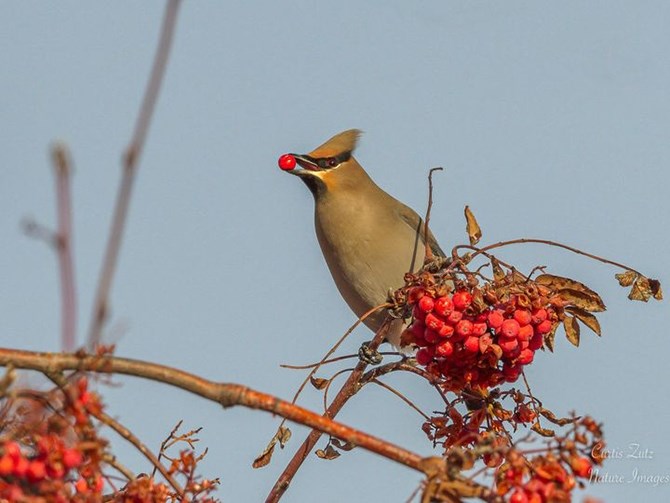
Bohemian waxwing
Image Credit: SUBMITTED/ Curtis Zutz
January 04, 2023 - 7:30 AM
With the passing of the Christmas season comes the tabulation of bird sightings happening throughout North America and it includes more than a dozen bird counts in the Thompson-Okanagan region.
But it wasn’t always this way.
“Prior to 1900, it was a bird hunt all across North American,” Chris Charlesworth, who organized two counts in the Central Okanagan this year, told iNFOnews.ca.
“In that time, there weren’t good binoculars so they couldn’t identify them unless they killed them and had them in hand.
"Some of these birds that are extinct or close to extinct, the last individuals were shot by scientists, kind of ironically. We’ve come a long way now. Any pair of binoculars will do the trick and you can identify a lot of the birds.”
The National Audubon Society in the U.S. explains the origin of the Christmas bird count this way: “Prior to the turn of the 20th century, hunters engaged in a holiday tradition known as the Christmas "Side Hunt," it says on its webpage. “They would choose sides and go afield with their guns — whoever brought in the biggest pile of feathered (and furred) quarry won.”
Ornithologist Frank M. Chapman, an officer in the newly established Audubon Society, changed that by proposing a Christmas Day bird count in 1900. He was joined by 27 others who conducted 25 bird counts in cities ranging from Ontario to California.
The Kelowna count, on Dec. 16, saw 60 people go out and count 105 different species, down from a five-year average of 107.
READ MORE: The gorgeous Thompson-Okanagan birds that survive the winters here
That came after more than a month of unseasonably cold and snowy weather that cut down on the number of species lingering in the area.
“In the fall, we had all sorts of interesting birds that were sticking around – summer birds that didn’t head south,” Charlesworth said. “Often, in a warmer winter, we get them on our bird count. Of course, this year we didn’t get anything like that. The early cold and snow either froze them or sent them south.”
READ MORE: Okanagan Christmas bird counts reveals surprises including hummingbirds
Even so, the Kelowna count was fortuitous timing since temperatures were around 1 Celsius that day but plummeted to a high of -17 C a couple of days later.
Kamloops, on the other hand, held its count on Dec. 18 when it only got up to -10 C.
While the temperature doesn’t seem to deter many of the serious birders, it may shorten their time outside and the activities of the birds, who tend to hunker down in colder weather. The weather also affects the travel patterns of migratory birds.
In Kelowna, 10,583 Bohemian waxwings were counted on Dec. 16. The previous record was 5,644 set in 1978.
“It’s probably just because the cold pushed them down,” Charlesworth said. “And there was a fairly good crop of the berries that they like.”
There was a bumper crop of mountain ash this summer. In years with poor berry crops, the waxwing sightings are low.
They breed in far northern forests.
“In winter these same birds become sociable nomads, with large flocks wandering the northwest in search of berries,” the Audubon website says. “Their numbers are quite variable from year to year (the name 'Bohemian' reflects their unconventional and seemingly carefree lifestyle).”
Another unusually common bird in the Dec. 16 count was the varied thrush. There were 266 sighted versus the old record of 29 set in 1965.
“I have a couple of theories why,” Charlesworth said.
“They appeared on the day when it got cold in early November. It could have been they were migrating in pretty big numbers south and the cold stopped them in their tracks and they suddenly needed to go to find a tree with berries and hunker down and try to survive. Or, they could have had a bumper breeding season as well. I know they were quite numerous across southern B.C. this winter.”
The thrushes look similar to robins but have a black band across their breasts.
Going out and counting birds is more than an excuse for enthusiasts to get together. It provides invaluable data on how birds have adapted to a changing environment, both the climate and the increasing density in cities like Kelowna.
“Over the last 100 years, it definitely has changed the bird scene,” Charlesworth said. “But the birds that are down in the city are pretty much adapted to urban life. There’s not a ton of woodpeckers and various forest birds down there. The birds that are down there are gulls, pigeons, waterfowl, geese. They’re all doing just fine.”
That doesn’t mean that all is well.
“If we chip away at little bits of habitat here and there around the edge of city, we’re gong to lose some of those forest or woodland birds,” Charlesworth said.
The compilation of all the bird counts won’t be posted online until later this year.
Results of past bird counts, by community, can be seen on the Audubon website here.
Birds Canada has a list of bird counts and contact information for compilers, here.
To contact a reporter for this story, email Rob Munro or call 250-808-0143 or email the editor. You can also submit photos, videos or news tips to the newsroom and be entered to win a monthly prize draw.
We welcome your comments and opinions on our stories but play nice. We won't censor or delete comments unless they contain off-topic statements or links, unnecessary vulgarity, false facts, spam or obviously fake profiles. If you have any concerns about what you see in comments, email the editor in the link above.
News from © iNFOnews, 2023